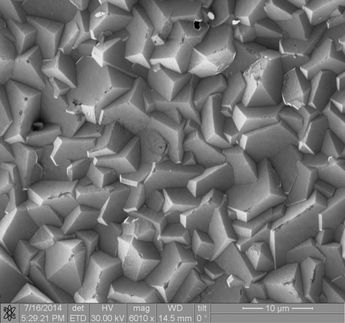Out-sniffing bomb-sniffing dogs
Tel Aviv University researcher leads development of swift, small, highly reliable sensor to detect explosives
dogs have long been called man's best bomb detector –– until now.
A Tel Aviv University scientist leads a research team that has developed a powerful electronic sensor to detect multiple kinds of explosives –– including those used in the recent Yemeni bomb threat. Based on nanotechnology advances, the new sensor is small, portable, and is more sensitive and reliable at detecting explosives than any sniffer dog, says its lead researcher Prof. Fernando Patolsky of Tel Aviv University's Raymond and Beverly Sackler School of Chemistry.
With scientific findings on it published recently in the prestigious Angewandte Chemie, the new device is attracting considerable attention from security companies and fellow scientists.
Capable of detecting numerous types of explosives, Prof. Patolsky says the sensor is especially effective at detecting TNT. Existing methods and devices used to trace the explosive have the drawbacks of high cost, lengthy decoding times, size, and a need for expert analyses: "There is a need for a small, inexpensive, handheld instrument capable of detecting explosives quickly, reliably and efficiently," says Patolsky.
According to the researchers, this new sensor can out-sniff even a champion sniffer canine.
Portable and hidden from view
The device is made from an array of silicon nanowires, coated with a compound that binds to explosives to form an electronic device –– a nanotransistor. In order to enhance the chips' sensitivity even further, the scientists developed each one with 200 individual sensors that work in harmony to detect different kinds of explosives with an unprecedented degree of reliability, efficiency and speed.
One major advantage of the new sensor is its portability - it can be carried from place to place by hand. It is also capable of detecting explosives at a distance. It can be mounted on a wall, with no need to bring it into contact with the item being checked. And unlike other explosives sensors, it enables definitive identification of the explosive that it has detected. To date. the device has not had a single detection error.
Security companies are taking note. The American company Nanergy Inc. has developed a prototype based on the patent, and is already in contact with potential partners to develop explosives sensors for the commercial market.
Headed by Prof. Patolsky, who recently returned to Israel from Harvard University, the research team is considered to be one of the world's leaders in developing nano-based sensors that can detect chemical and biological molecules.
Such sensors may be used to detect not only explosives, but also biological toxins and threats, such as anthrax, cholera or botulinum. Looking beyond national security, the sensor offers attractive applications in the medical field as well.
Other news from the department science
These products might interest you
Most read news
More news from our other portals
See the theme worlds for related content
Topic world Sensor technology
Sensor technology has revolutionized the chemical industry by providing accurate, timely and reliable data across a wide range of processes. From monitoring critical parameters in production lines to early detection of potential malfunctions or hazards, sensors are the silent sentinels that ensure quality, efficiency and safety.

Topic world Sensor technology
Sensor technology has revolutionized the chemical industry by providing accurate, timely and reliable data across a wide range of processes. From monitoring critical parameters in production lines to early detection of potential malfunctions or hazards, sensors are the silent sentinels that ensure quality, efficiency and safety.


































































